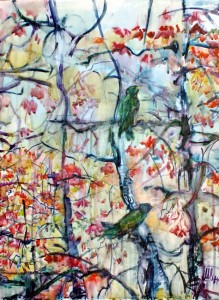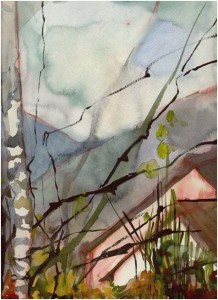To pause and look back…
(excerpt)
“So that’s it – our real link
with the secret world!”
Osip Mandelstam, Stone
Translated by Burton Raffel and Alla Burago
When I visit art galleries, I always expect a miracle. Will the artist’s creations captivate me? Will I want to return to a piece I liked? Will a painting talk to me, envelop me with its own mood? With this feeling I was going to visit Maya Gerr’s exhibition.
It was a snowy day – just like a theater set. Not sunny, just snowy; snow, snow, and wet purple roads. And the studio’s numerous doors and zigzagging brown walls, so dark and forlorn, also made it to look like a theater set. And suddenly – a feast of colors, flowers, sun, and the author – a charming young woman, warm and inviting, with wonderful command of Russian she hasn’t lost in emigration. I never tire of listening to good Russian, especially when it expresses such innate honesty.
– So the beginning. How did it all start?
– Not quite like for everybody else. After school I had no idea what I wanted to do. I fell in love with an artist! And decided I wanted to speak the same language with him. Made my choice…
– And the love?
– In the past. (She’s laughing)
– But it’s replaced by the art. Surely the artist’s touch must run in your veins?
– No, I come from a very technical family. After school I took classes at various art studios, approaching the matter seriously. I had such wonderful teacher-student relationships, which, unfortunately, are a mostly lost these days… Then there was the Moscow Textile Institute with its wonderful art department. Then I continued my studies at the Theater Academy – it interested me a lot; my student works were connected with the class of Mark Zacharov (renowned Russian movie and theater director): I did set design for his students’ performance of “Romeo and Juliette.” But my heart lay in oils and watercolors – such was my long way to painting. I came to Boston six years ago from Heidelberg, Germany, where I had lived for five years.
– European outlook on painting is very different from the American one…
– More boring, in my opinion. Germans are less dynamical, more calm. It’s easy to see it in my paintings, as well. Some of my pieces were purchased by German collectors, but I brought here quite a few, too.
– When I enter a room, I always try sensing the atmosphere: whether it pulls me in or pushes me away… Here I’m very comfortable.
– Thank you, I’m glad to hear it. This piece I painted last summer. Actually, these are experimental. It’s a rare technique – watercolor on canvas. Honestly, I’ve yet to see anyone else to employ it. Since I’ve never learned anything like it, either, I had to invent it myself. I don’t know, maybe there are certain rules… I’m feeling my way around, experimenting as I go along. You can see the texture, can’t you? I’m attracted by the fabric; I like showing it. Look at these flowers. I’m turning the light off – stripes shine through the paint ever so slightly, like the light from within. It’s the transparent Maine; I painted it last summer. And those are from Heidelberg.
– It’s as though it’s painted by a different artist… Different style. More stern, I’d say. Spring, trees are just beginning to bloom… Not a very festive spring, but a quiet and taciturn one…
– The German series is called “A View from the Window.” Indeed, my apartment had the most incredible, striking view: a medieval castle, its dark silhouette raising against the sky. Some parts of the castle are restored, but even the ruins are very picturesque. The university, which is over 600 years old. Philosopher’s Walk. Early Renaissance. An incredible town. Forever young, because it’s a college town. Hegel himself taught in this university… But what am I telling you – look!
And I’m looking, and the sounds come to me: old harpsichord, Bach’s fugues… The breath of history, the smell of centuries – perhaps, the snow behind the windows and the dark room with red brick walls are increasing the impression. It’s not one-dimensional. The reality is mixed with the imagination, adding a ray of bright light.
I’m looking at a landscape.
– This painting used to hang in my husband’s office. Once a visitor noted with a great surprise that he knew the place very well. I’m sure I just picked the mood that agreed with the current mood of that man, which is why the place seemed familiar to him, even though the landscape featured no precise landmarks. It was vague, but there was something in that vagueness, some mysterious connection. (She’s laughing.)
– There is a parrot on a tree branch. One eye – oh so colorful! And fish. I love painting of fish… Yours are alive. They’re swimming in lettuce-colored water. You have such a diverse palette. You’re trying yourself in various styles, there is something from impressionism, even pointillism… Storing up everything?
– The life is hundred-dimensional; mood, conditions – everything can give one a hint. For instance, when my son was five, we bought him a construction set – colorful cardboard pieces one could use to build something. Here, I made an ornament, just somewhat changed the shape.
– There are also elements of avant garde, cubism, especially in the latest works.
– It’s the traces of textile. They remain, dwell inside me. I painted these pieces after a large break – after my daughter was born. Suddenly something burst out, something that lives deep within and eventually goes out, when the time comes. So it did.
– It’s not your first exhibition, is it?
– No. Others were elsewhere, though. I even have my own circle of fans, and not just artists – my husband is a scientist, his colleagues, our friends…
* * *
It’s always a mystery to me why one wants to pause by a particular painting, think for a while, leave, and then come back and listen to oneself and notice how one becomes more peaceful and friendly toward others…
Lines on visitors’ faces become replaced by smiles… I can’t judge the craftsmanship – size of brush strokes or transparency of watercolor. But I can see energy transforming from one form into another. The tension in the fingers joined with the mind’s eye, born in the imagination, suddenly spills onto fabric, paper, canvas. Spills out how? Why some plots, landscapes, configurations draw one’s eye while others make one want to run as fast as one can? We’ll discuss it with Maya next time, at her next exhibition. Which, I hope, will take place in a bright, spacious room where her distinguished art will shine and bring joy to everyone. Because she’s got talent! It’s a fact that Maya is a bright and talented person. She’s in quest for herself, and, looking at her paintings, we also discover our own world. Her paintings – her watercolors on canvas – are a trembling, acute awareness of life itself; even though she paints flowers and landscapes, it has much more to it – it’s all about the life of the soul…
Tatyana Feinberg
Contact magazine, February 2010
Translated by Yuliya Shulman


